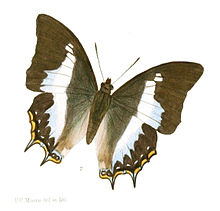Polyura schreiber
| Blue nawab | |
|---|---|
 |
|
| Polyura schreiber wardii | |
| Scientific classification | |
| Kingdom: | Animalia |
| Clade: | Euarthropoda |
| Class: | Insecta |
| Order: | Lepidoptera |
| Family: | Nymphalidae |
| Genus: | Polyura |
| Species: | P. schreiber |
| Binomial name | |
|
Polyura schreiber (Godart, [1824]) |
|
| Synonyms | |
|
Polyura schreiberi (unjustified emendation) |
|
Polyura schreiberi (unjustified emendation)
Polyura schreiber, the blue nawab, is a butterfly species found in tropical Asia. It belongs to the Charaxinae (rajahs and nawabs) in the brush-footed butterfly family (Nymphalidae). It occurs from south India and Assam through Myanmar, Tenasserim, and Southeast Asia to southern China and to Java, Indonesia.
The South Indian subspecies:
Male has upperside ground colour black, glossed slightly with dull indigo-blue, or, in some specimens, light green at the base of the wings. Forewings and hindwings with a broad white discal bar from interspace 4 in forewing to just below the apex of the median vein in the hindwing, narrowing on the latter wing to a point. This bar has, on the outer side on both forewings and hindwings, an irregular border of small-blue, which is narrowest anteriorly and broadens posteriorly respectively on both forewings and hindwings. Forewing with, in addition, a white rectangular spot in interspace 5 and a small whitish speck above it. Hindwing with a subterminal row of small white dots, a terminal row of deep ochraceous spots, and some small-blue markings on the tails and margins near the tornal angle. Underside pearly white, broadly brownish pink along the dorsal margin of hindwing. Forewing: two black spots at base of cell; a broad olive-green band edged on both sides with black, followed by a discal bluish-white band, as on the upperside, and continuation of that on the forewing, terminating on vein 1, followed by a broad discal, posteriorly narrowing, white bar as on the upperside. Beyond this a postdiscal series of deep Indian-red lunules, placed on an olive-green ground, and margined on the inner side by an interrupted broad black line; finally, a sub-terminal narrow green band and terminal ochraceous lunules. Tails black touched with small-blue; above tornal angle a black line from vein 1 to dorsum. Antennae, head, thorax and abdomen black; thorax and abdomen on the sides and beneath whitish.
...
Wikipedia
